With Remembrance Day fast approaching, I’m remembering people who were important in my life and looking at how the Memory Posts I painted in their honour are faring.
The inspiration for my Memory Posts came from a visit to the National Gallery of Australia and its Memorial Hall. Created by indigenous artists from Central Arnhem Land in Australia’s Northern Territory, The Aboriginal Memorial is an installation of 200 hollow log bone coffins.
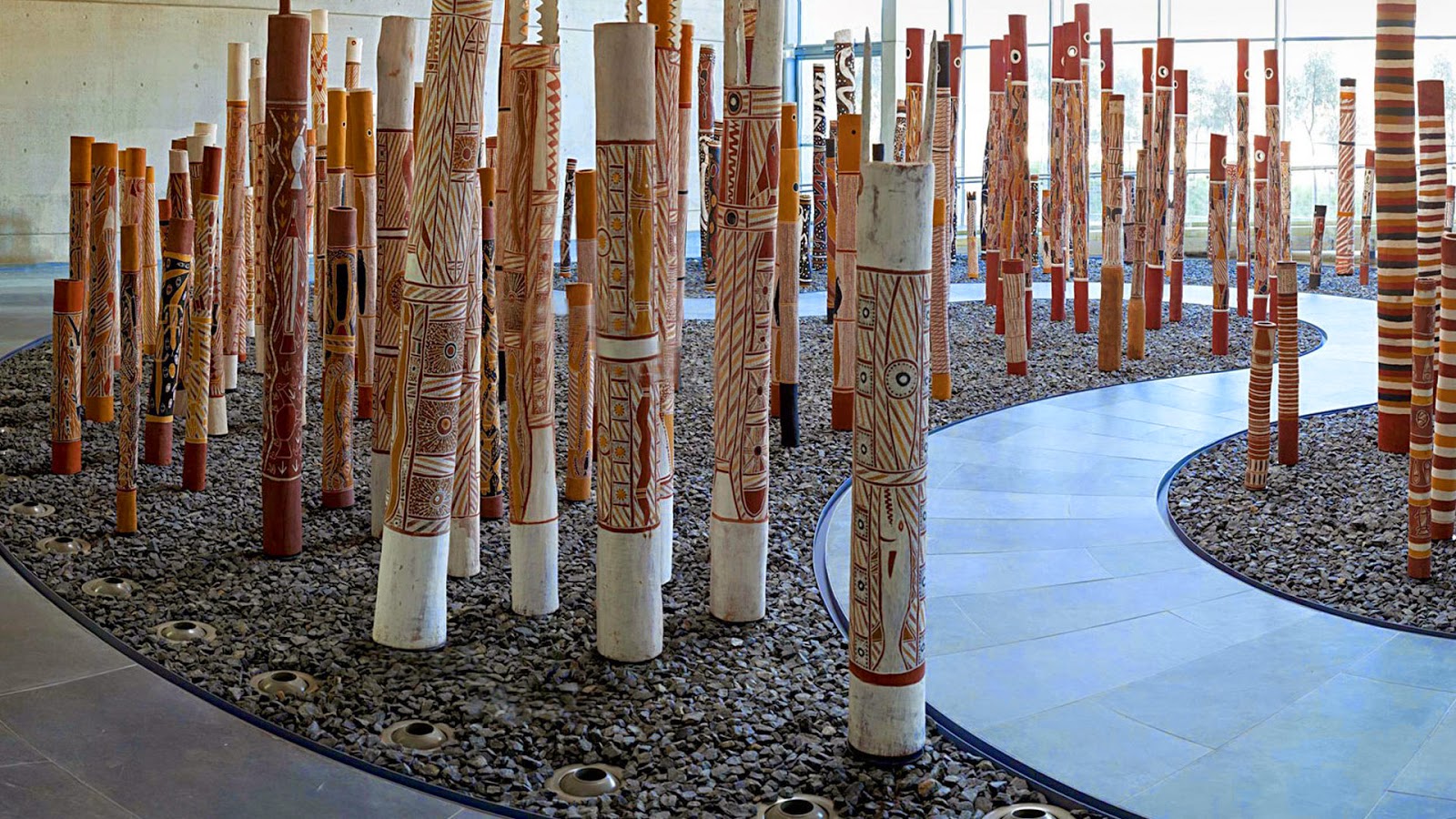
Photo courtesy of the National Gallery of Australia. The curving path represents the Glyde River in central Arnhem Land. The poles are placed along the river according to their specific homeland.
Walking the curving path that leads through this forest of painted logs was an overwhelmingly emotional experience. The hollow logs were beautiful objects in themselves, intricately painted in a traditional cross-hatch pattern that makes the designs shimmer and sing. More than that, though, was the symbolism. Covered with totemic patterns meaningful to the clan from which they came, the two hundred logs represent the 200 years from the first year of European settlement in 1788 to Australia’s bicentennial in1988 when the memorial was installed. Together they tell a story of transition and regeneration. They celebrate life while remembering the past.
I visited this Memorial Hall several months after my father died in 2006, at the age of 90. Seeing the painted logs inspired me and I wondered if I could honour him and his life in a similar way. The prospect was daunting but I decided to try.
It took me many hours over many months to paint my father’s memory post. I didn’t rush, I relished the time spent remembering him. A pine tree about 16 feet tall had been cut down a few weeks before I began and I decided to use half of it for his post. With the Australian hollow logs in mind, I covered the pine bark with a complex pattern of dots and lines, symbols that spoke of him and of Virginia where he grew up. When the post was finished, I put it in the garden among a forest of ferns.

I used colours that reminded me of Australia and a similar dotted style but the patterns recalled my father and Virginia.
It was early spring when we installed the post, and the ground was still cold with patches of snow. Over the summer the post became a destination. I walked past it almost daily, pausing for a moment to trace a pattern and to remember. In winter the post brought colour to a cold, white world.
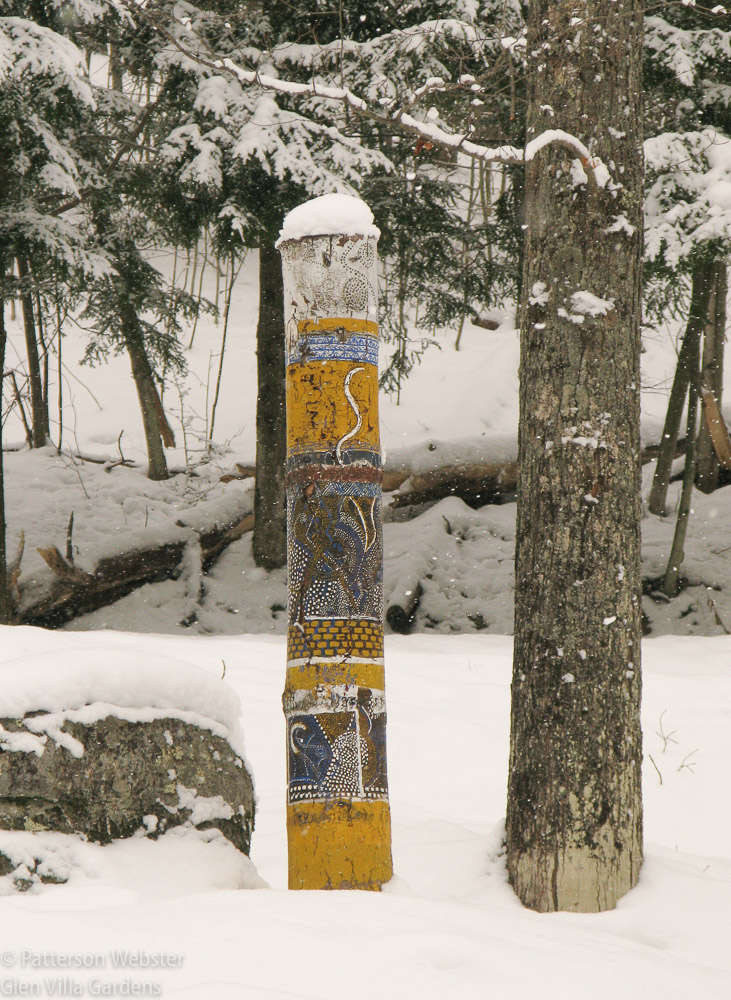
I think that the cap of snow sitting on top of his Memory Post would have made my father laugh — he grew up outside a small Virginia town called Snowville.
The following spring I erected a second post in honour of my brother-in-law. Since he and my father were good friends, I used the other half of the pine tree that I used for my father’s and put the two posts close together, near a rock that anchored them in place.
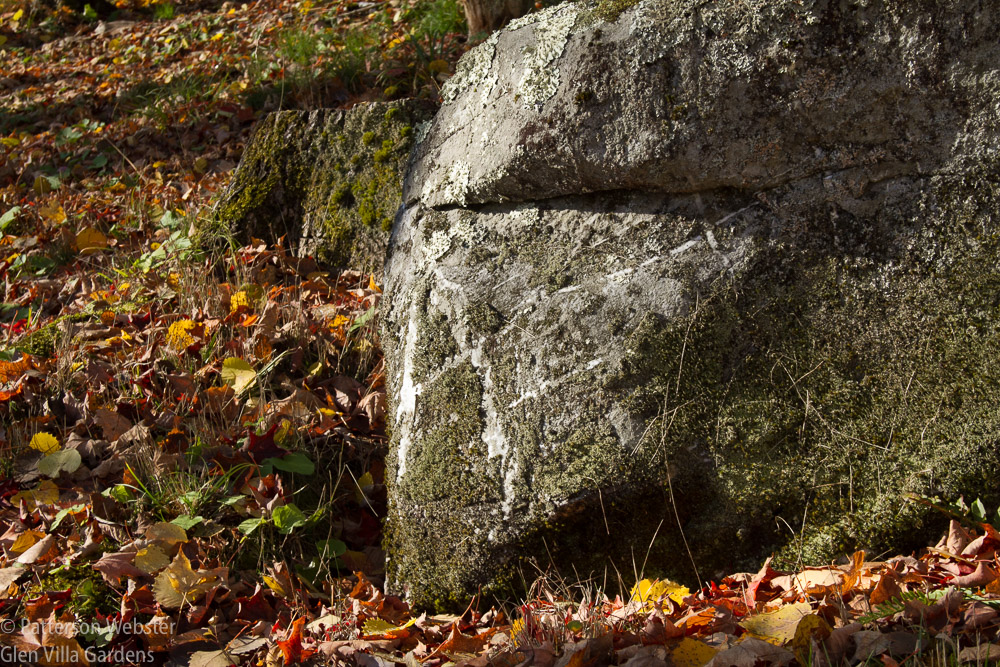
A rock marked with the first letter of the alphabet determined the location of the two memory posts. It seemed appropriate since from my beginning my father was with me.
The two posts are very different in spirit. I painted my father’s post with sorrow, my brother-in-law’s I painted with anger — he was much too young when he died. I gouged out the wood, burned the cuts and added touches of blood red in the incisions. But almost by chance, the gouges seemed to smile and dance with life, as he had.

My father’s post is in the foreground, my brother-in-law’s in the background.
The posts have weathered now. A few years ago, the bark began to lift and fall off. What to do became a question. I thought about protecting the posts in some way — putting them into glass cases perhaps, or removing the bark and repainting the posts entirely.
I decided to do nothing. Left to the elements, the posts would complete a cycle, rotting to enrich the earth.
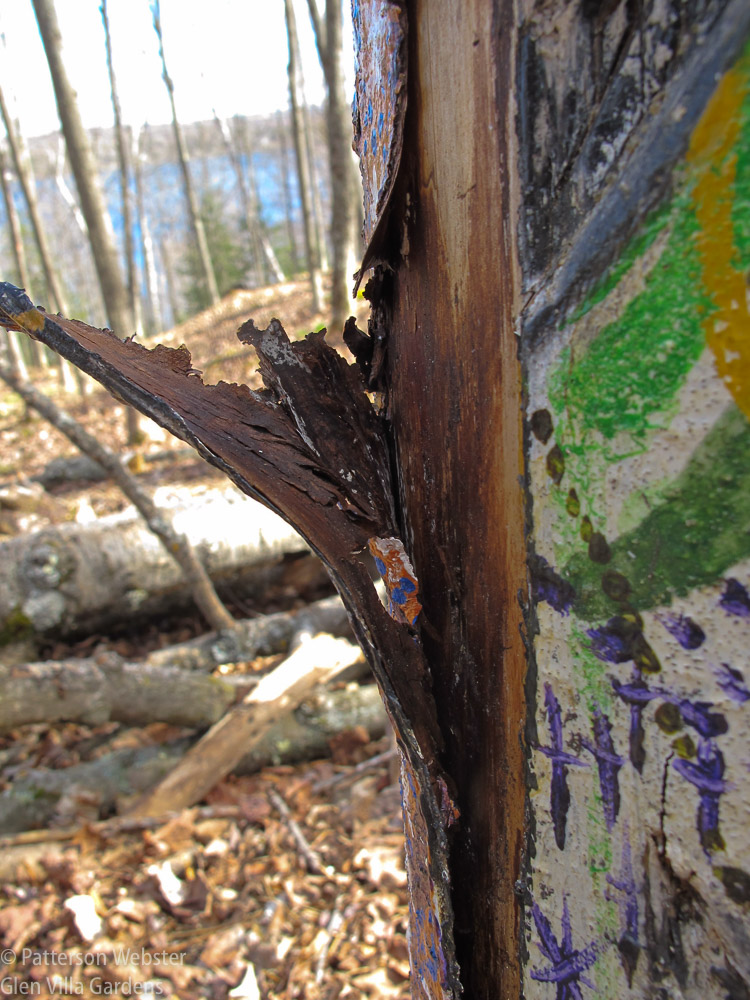
If I had removed the bark and painted directly on the trunk, the patterns would have remained longer.
Ten years later, the painted portions of the posts have almost disappeared. Traces remain around the knotholes where branches grew and occasionally I’ll find a piece of painted bark on the ground. But now from a distance it is hard to pick out the memory posts from the living trees that surround them.
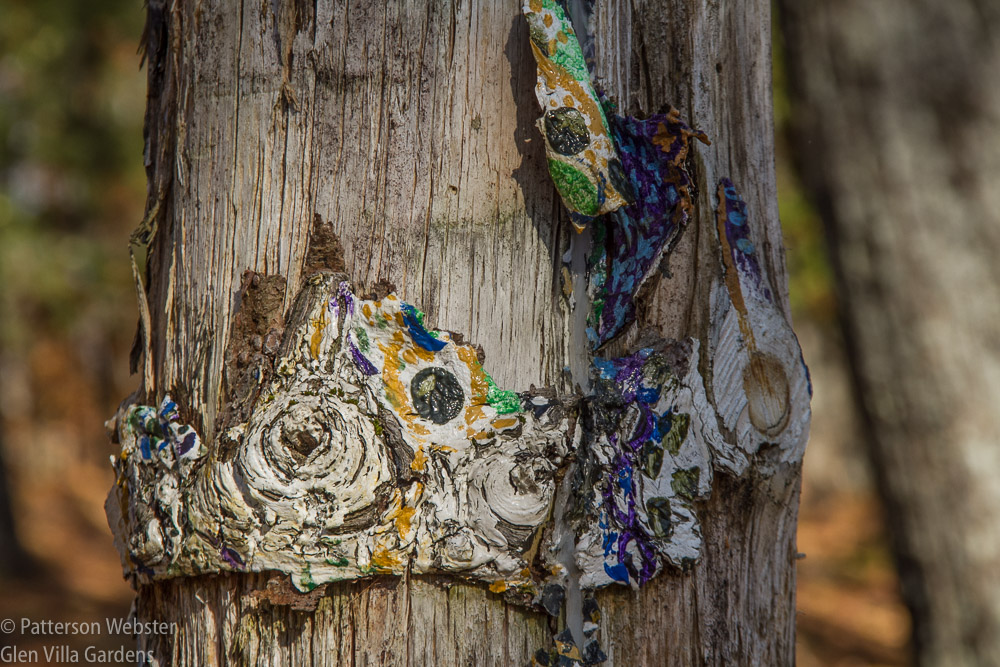
Paint adheres still to some parts of the trunk.
That isn’t the case with the third Memory Post, painted to remember a sister-in-law. Instead of pine, I used cedar for her post, and stripped the bark before I began to paint. The design is totally different as well — she loved turquoise and peachy salmon so her post uses both colours on a background of gold.
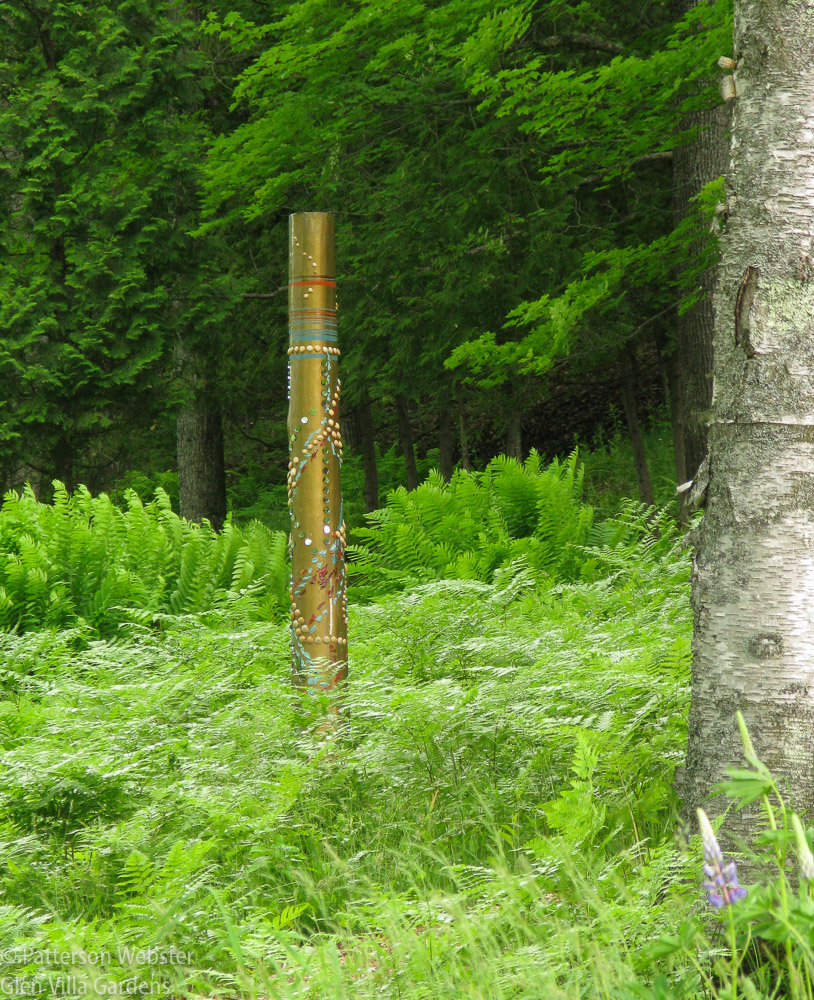
This Memory Post stands in the same section of the fern forest but at some distance from the other two.
It also includes strands of jewellery and seashells I collected on a beach in Florida where I was staying when she died.
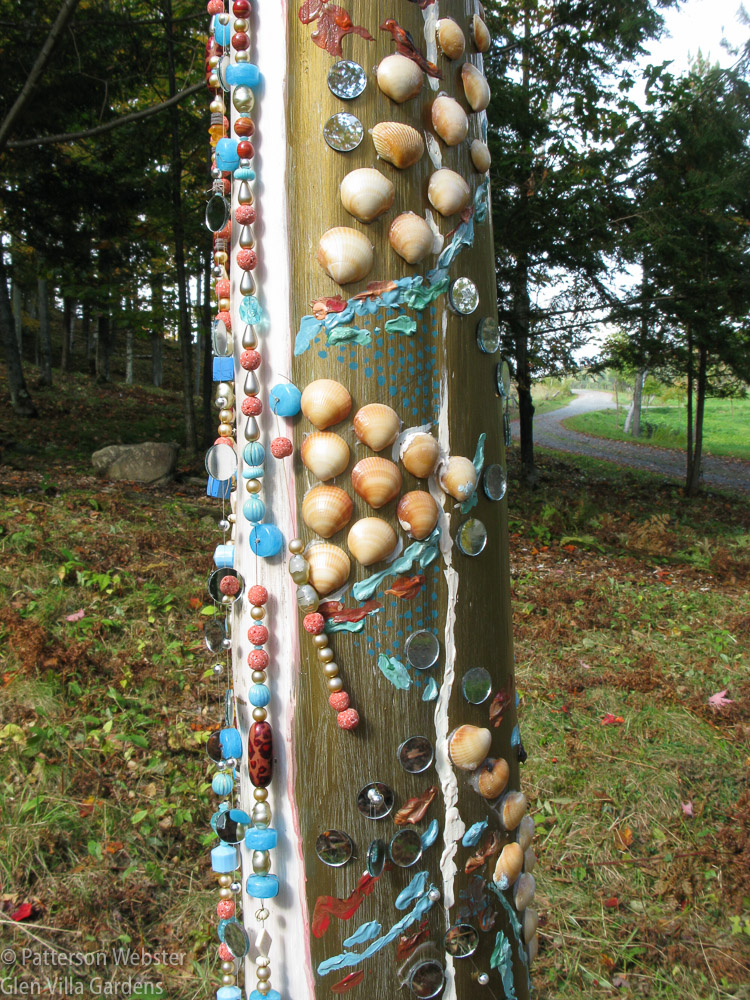
The paint is thick and textured on this post, unlike the smooth dotted patterns on the posts of the two men.
I hesitated before using mirrors on this third Memory Post, fearing they would be seen as signs of vanity, particularly on a post painted in honour of a woman. I included them, though, because I wanted to connect anyone looking at the post to the world around them. Reflected in the small mirrored circles, passers-by see themselves within their surroundings, not separated from nature but a part of it.
Because I stripped the bark and painted directly on the cedar tree trunk, my sister-in-law’s Memory Post is weathering more slowly than the other two. But after eight years it too is showing signs of age.
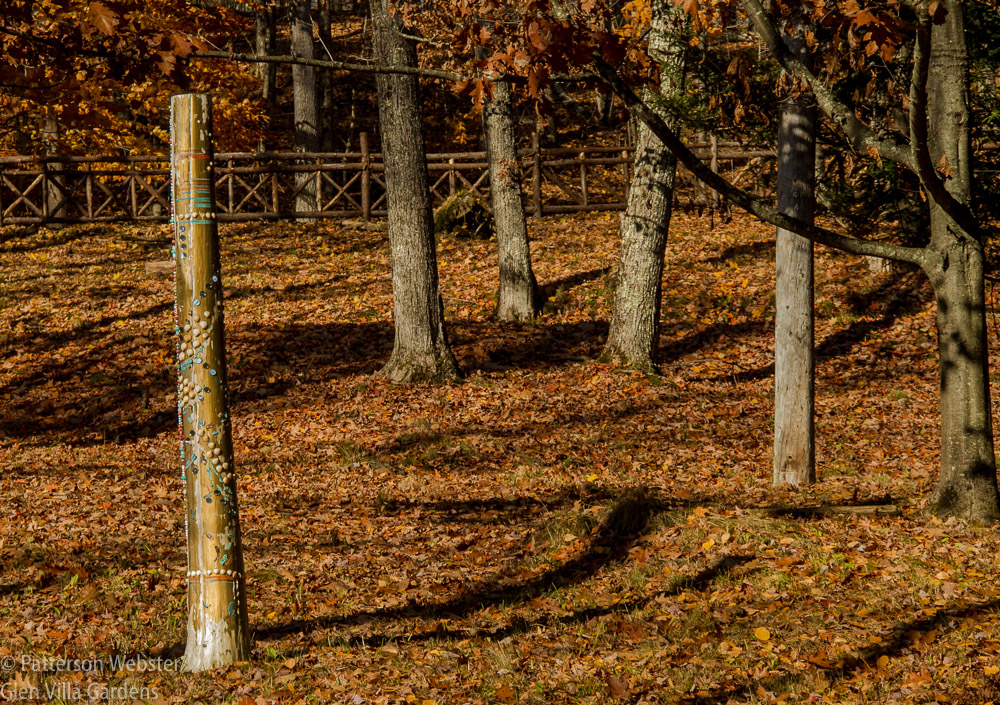
On an autumn day, the gold post blends into the golden tones of fallen leaves.
Fading paint does not mean fading memories. Those remain as strong as ever. Like the aboriginal tradition that inspired them, these posts represent the spirit of people who were important in my life and their presence in the woods today keeps that spirit alive.
November 11 is called Remembrance Day throughout the Commonwealth countries. It is called Veterans Day in the United States. It is also my birthday and the day that my mother died, six years ago.
For the last six months I’ve been working on her memorial. It isn’t a post, it is a section of the garden that I’ve named the Upper Room. I hope to complete it before winter comes. But if it takes until spring, that will be fine with me. The point isn’t to finish, it is to remember.

Who will you be remembering on Remembrance Day?




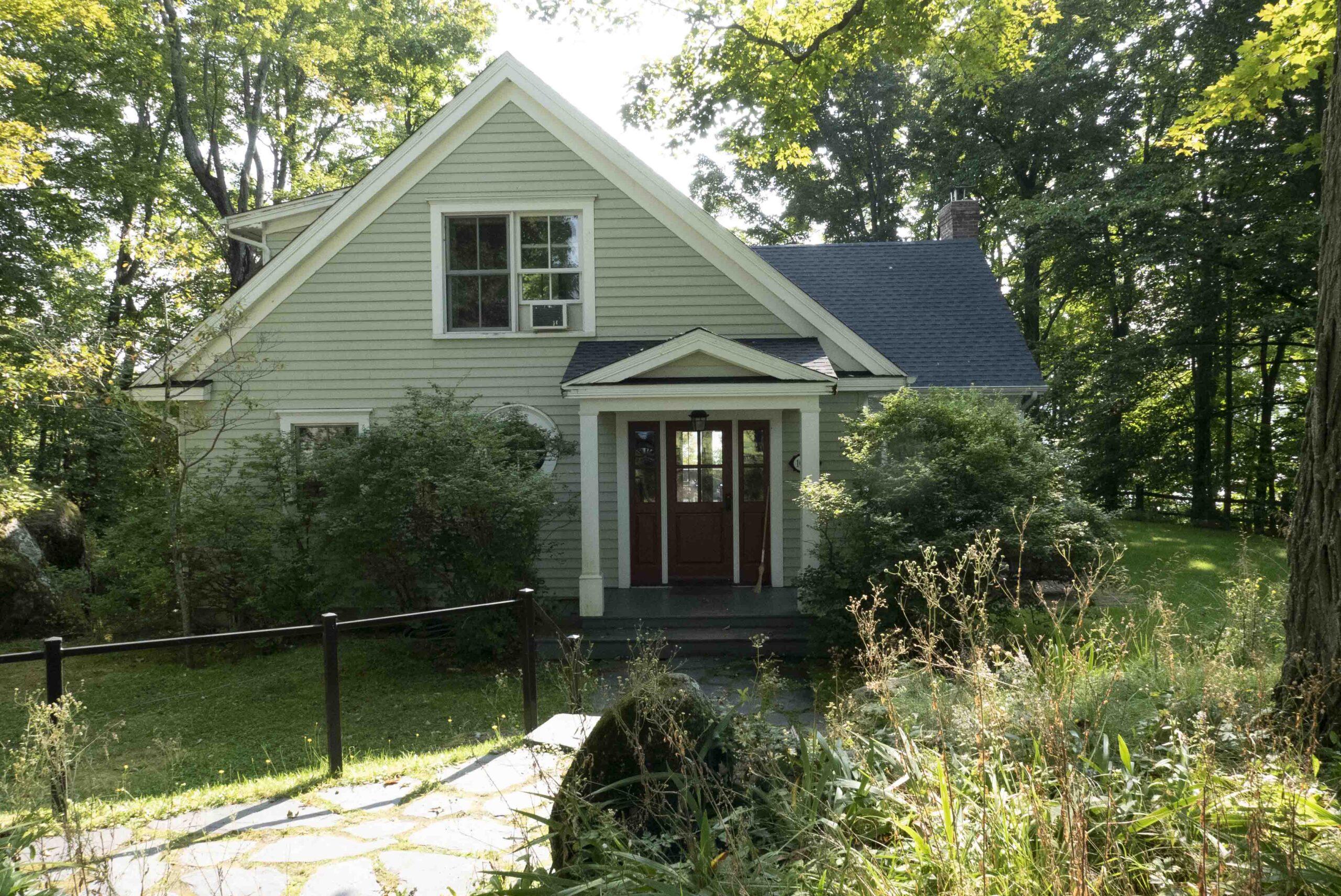
Pat, this is beautiful, both artistically and emotionally. I am looking forward to seeing your mother’s remembrance. Both of your parents were special and outstanding people, most worthy of remembrance.
Thank you, Roberta. We were both lucky with our families, and remembering them is a joy.
Pat,
Your words and your work are very poetic. You have found a very original way to memorialize those who have passed and to communicate regeneration on materials as they weather. Art and garden in perfect unity.
Best wishes from Metis,
Alexander
Thank you, Alexander. “Art and garden in perfect unity”… a fine compliment.
Loved your post…unique way to honor with love your missed ones. Remembered your parents and Putt. We are living at Blackberry Farm in Walland Tennessee…surrounded by beauty and peace. HB 73! Love, Linda
Great to hear from you, Linda, and to know where you are these days. I’ll have to locate Walland, Tenn. on a map. Took me a minute for figure out the HB message… you have it right!
This beats that stone cold granite business, doesn’t it! My Mother’s birthday is on the November 11 too, she would have been 95 this year. Colorful Mooring Poles on Grand Canal in Venice, Italy
During your first ride down the Grand Canal in Venice you’ll be in awe of the colorful buildings, called a palazzo or palace, that cling to the waterline. Most were built by wealthy aristocrats. In front of them are mooring poles. These pali are used to secure boats. The colors of the stripes represent the family that originally owned the residence.
I hope I make it to 95, Robert! The connection with Venetian mooring poles had never occurred to me… interesting connection. They are used with great effect at Naumkeag, a garden in Massachusetts, where they outline the morning garden. Maybe there was a double entendre?
Beautiful tributes to those you have loved and lost, keeping their spirits alive in your mind and heart.
Thank you, Kay. It’s good to remember loved ones when doing that makes you feel warm inside.
Interesting that the paint remains only near where branches grew; holding fast to the succeeding generation as represented by the tree of life. I love that you’ve made each pole with such care and then found a place where they can be a part of your daily life. My father died in 1968, at just 36 years old, but I’ll be remembering my mother for the first time this year.
Oh, Marian, what a sadness, to lose a father so young. Your mother must have been a very special presence in your life as the only parent for so many years.
I hadn’t thought of the connection between the branch joint and the succeeding generations. A very nice sentiment.
Wonderful, creative tributes to those you have lost, a sense of peace permeates each. Best wishes.
Thank you, Eleanor. You are right, there is a sense of peace — painting the posts was cathartic.
I absolutely love these memory posts, Pat. So much that I may very well do something similar. I’ve had a circle of rad painted posts in my garden for years, so some kind of precedent has been set already. I’ve often wanted a way to memorialize people from the past in the garden. (My first “garden” was the cemetery in Canton, Mississippi, where my parents are buried.). I know exactly where they would go.
James, I am touched that you would choose to do something similar to the memory posts. I made a mental connection with your red painted posts as soon as I saw a photo of them. I think I now know as well that we share a certain fondness for cemeteries… a house we lived in many years ago backed onto one and I always found it comforting in a strange way.
A very moving article with beautiful photos….a thoughtful and creative way to remember those close to you. Inspiring.
Thank you, Marilyn. Reading how so many people responded to this post has given me a big lift. I appreciate your comments.
I love the Memory Post for your sister-in-law. Even though I never met her, it gives meAs a sense of her character. Your explanation is very moving. As another commenter said, this is far more expressive than a stone monument.
Stones are hard and cold, something very few people are. But stones have their uses… I’m installing one with engraved words in the woods for a new project that I will write about once it is done.
Your memories make the spaces sacred.
Happy Birthday.
Cheers,
Katie Kinnear
Thank you, Katie.